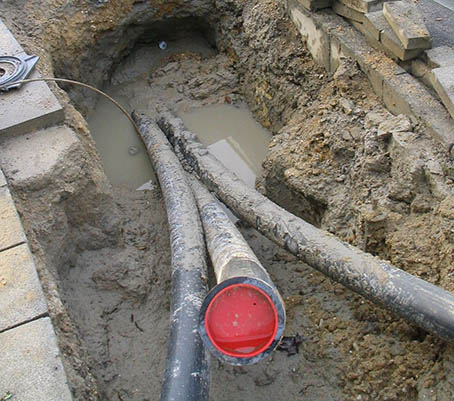How to Put in a Code-Compliant Underground Electric Conduit
With one significant exception—running underground cable—extending electrical service to a detached garage or other outbuilding is quite similar to installing a circuit inside the home. You might be able to run a circuit to a detached outbuilding yourself if you have enough confidence in your wiring abilities to feel at ease adding an electrical circuit inside.
However, you should be aware that it requires labor for boring pipe conduit wire installation and connecting one or more new circuit breakers at the main circuit breaker panel. This type of boring pipe conduit wire installation is frequently left to professionals, and for good reason—if you don't know what you're doing, working on the main service panel could result in a very dangerous or lethal shock.
Tip On Boring Pipe Conduit Wire Installation
Before you dig, be aware of your possibilities. Direct burial at a depth of 24 inches maybe you're the best option if you're laying cable in a spot that won't be disturbed. If you intend to run the wire through an area of your yard where excavating for another project may take place in the future, bury it in one of the conduits at the specified depths.
Add New Circuits Or Extend Existing Ones
Even while it is theoretically possible to simply extend an existing house circuit by extending an additional wire out to a garage or other outbuilding, the majority of local Code requirements will need you to run one or more new circuits.
Here are standard recommendations on boring pipe conduit wire installation:
Install one 15- or 20-amp 120-volt circuit in the garage to power the ceiling lighting fixtures and one or two wall outlets.
Install two 20-amp circuits if you intend to use 120-volt tools in a small workshop.
Install an electrical subpanel in your garage if you want to operate a lot of tools or one or more 240-volt tools.
Only when the circuit is already serving a deck or outside outlets may it be extended to an outbuilding, and you must ensure that the circuit's capacity won't be exceeded by the additional lights and outlets in the garage. Make sure your local Code permits a straightforward circuit expansion.
How To Do Boring Pipe Conduit Wire Installation
In this illustration, we'll be threading UF cable or individual THWN wires through Schedule 40 PVC pipe. The procedure of boring pipe conduit wire installation is the same whether employing robust metal conduit or direct burial of UF cable.
Create a trail using rope or a garden hose for the wiring to travel from the home to the garage. Always take the quickest, direct route.
Dig a small channel from the house to the garage using a trenching shovel at the recommended depth for the boring pipe conduit wire installation you're undertaking. If you need to dig a lengthy trench, you might want to think about hiring trenching equipment for boring pipe conduit wire installation.
If it's essential to cross a sidewalk, dig the trench down to the necessary depth on both sides, then drive a piece of rigid pipe or conduit horizontally to bore a hole beneath the sidewalk. After that, pass the conduit through the hole you drilled in the sidewalk.
Lay the conduit into the trench, using PVC solvent glue to solvent-weld the connections between each segment. Attach sweep fittings to vertical conduit lengths that rise out of the trench at each end.
Fish tape should be extended through the conduit from one end to the other. The fish tape is used to connect the end of the UF cable (or individual THWN wires), which is then gently pulled back into the conduit. This task is made significantly simpler by having a helper feed the cable from one end while you pull on the fish tape. Pulling the cable will be simpler if cable lubricant is used.
A good amount of extra cable should be left at each end of the conduit run so that an electrician may finish the connections inside the house and the garage.
If your local Code requires it, have the inspector declare the trench "passed" before filling it in.
The inspector will check after boring pipe conduit wire installation to make sure your conduit is buried deep enough before giving you the all-clear to finish filling in the trench and installing the circuit.
You can now finish the hookups by extending cable into the house and garage. As wires enter the interior of the house and garage through the walls, make sure they are all enclosed inside the conduit after boring pipe conduit wire installation. The next stage will be to connect the circuit breakers at the main service panel after wiring the garage's outlets and lights.


.jpg)
.jpg)


Comments
Post a Comment